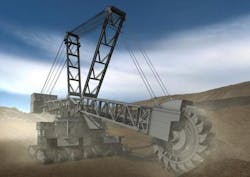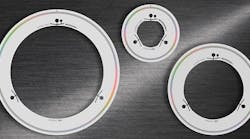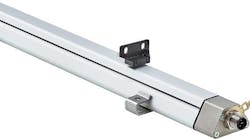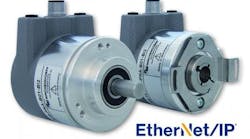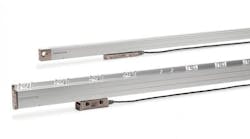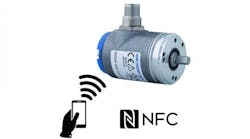What It Takes for Encoders to Gain the "Heavy-Duty" Title
Open-pit excavators and spreaders are real giants among machinery. Every day they do the hardest work under extreme conditions—dust, dirt, rain, heat. A great strain also imposed on the rotary encoders, which are responsible for speed control of conveyor belts. Many manufacturers, therefore, rely on HeavyDuty encoders from Baumer Hübner. What does it take for encoders to deserve the hallmark "HeavyDuty" title?
Minera El Abra is an open-pit copper mine, located 75.6 kilometers northeast of the Chilean city of Calama. Mine output per day is more than 200,000 tons of copper ore for copper cathode production. Conveyor belts transporting the ore over many kilometers must deliver maximum performance. For doing so, they are driven by powerful electric motors. HeavyDuty incremental encoders HOG 10 by Baumer Hübner are ideal for motor speed feedback in such a demanding outdoor application. They endure dust, dirt, vibration, and other harmful impacts that are every-day occurrences in open-pit mines. 10,000 kilometers away, at the port of Rotterdam, the brother model POG 10 is on duty: In the largest port of Europe, more than 300 million tons of bulk cargo are handled every year, including more than 55 million tons of iron ore and coal. These intermediately stored goods are handled with bucket wheel excavators with a capacity of 5,000 tons per hour. HeavyDuty encoders by Baumer Hübner were chosen for this application because they withstand salty air, rain, and frost without any problem. These are just two examples of how HeavyDuty encoders have proven themselves in tough and challenging tasks for many years.
"HeavyDuty"—precision under heavy load
The English term "HeavyDuty" means extremely resilient, so HeavyDuty encoders are said to be particularly robust. But that's only part of the story and does not only refer to robustness. The term implicates the promise that such encoders will reliably and precisely perform over a long period of time without ever letting users down. For this, HeavyDuty encoders must meet several criteria:
Precision is a focal point. Anyone believing these encoder heavyweights could afford to compromise on this factor is on the wrong track. On the contrary, HeavyDuty encoders must deliver the same precision signals as their little brothers. Plant control systems use these signals for speed monitoring at drives or position feedback at machine parts. To controllers, this is the only way to "get informed" of any excess speed or the drive falling below a defined speed limit so they can intervene accordingly. Even minor measuring errors can have drastic consequences that may result in system damage, e.g. in bulk material conveyance.
Robust technology for maximum system uptime
Besides precision, reliability is likewise important—as shown in the examples of open-pit mining and bulk material transport. For reliable performance in the harsh conditions present in open-pit mines and port installations, the encoders must withstand hard shocks, vibration, and other shaft impacts without losing their precision capabilities for many years. Product exchange is expensive, not because of encoder pricing but because of installation in places difficult to access and system downtime for the time of exchange. Robust, thick-walled housings and a shock and vibration resistant interior are basic requirements. In addition to that, Baumer Hübner encoders provide generously dimensioned bearings with large bearing spacing at both shaft ends.
Not only mechanical robustness but also electrical resilience is a must. For example, if electromechanical fields generated by live, unshielded cables are present close to the encoder. Without appropriate shielding, the encoder electronics may be destroyed or at least be impaired to an extent resulting in measuring signals of bad quality. Shafts currents generated by voltage difference may burn the bearing lubrication and lead to bearing damage or destruction. Electrical isolation is therefore indispensable for HeavyDuty encoders.
Tightness is another must. Whether moisture, dust or dirt—HeavyDuty encoders must be well sealed. This is especially important at critical, neuralgic points: shaft and electrical connections. Sealing includes corrosion protection by appropriate materials and coatings, against ingressing saltwater and chemicals that would impair encoder functionality.
Original HeavyDuty encoders
"HeavyDuty" is neither a protected concept nor a standard but has become an established term on the encoder market. The inventor of this special encoder class is the world market leader Baumer Hübner with HeavyDuty encoder expertise dating back to the 1950s. This know-how and experience have incorporated into the development of HOG 10 considered to be the "original" for more than 25 years and the blueprint for every HeavyDuty encoder. Baumer Hübner HeavyDuty encoders not only excel by precision, reliability, and durability, but also by the wide selection of product variants with varied mechanical, electrical, and functional options. Incremental and absolute encoders are available in 58 mm housings and as large designs with 287 mm flange size and 150 mm hollow shaft. Baumer Hübner encoders support all relevant analog and digital interfaces. High power outputs ensure excellent and noise-immune signal quality even over long a distance—depending on the product variant up to 550 m, in fiber optic transmission even up to 1.5 km.
The Baumer HeavyDuty sealing concept ensures IP 66 and IP 67 protection over a wide temperature range up to +95°C. The sophisticated combination of labyrinth and shaft seals permanently protects the HeavyDuty encoders against all types of solids, moist and contamination by adherence.
To ensure fail-free operation, electrical functionalities and signal quality undergo 100 percent inspections at Baumer Hübner. Comprehensive quality certificates certify customers' absolute encoder reliability. No matter whether copper mining in Chile or bulk materials handling and transport in the port of Rotterdam, HeavyDuty encoders by Baumer Hübner ensure permanent operation reliability without downtime—even under the toughest conditions.
